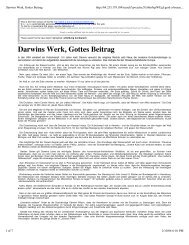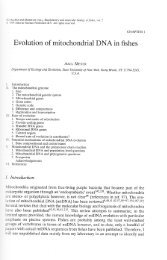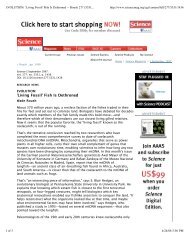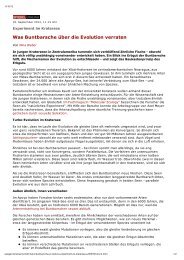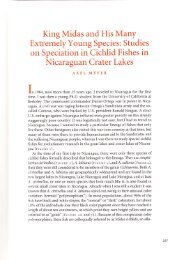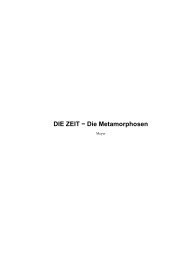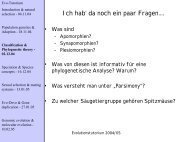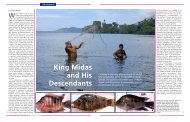TaxI: a software tool for DNA barcoding using distance methods
TaxI: a software tool for DNA barcoding using distance methods
TaxI: a software tool for DNA barcoding using distance methods
You also want an ePaper? Increase the reach of your titles
YUMPU automatically turns print PDFs into web optimized ePapers that Google loves.
<strong>TaxI</strong>: a <strong>software</strong> <strong>tool</strong> <strong>for</strong> <strong>DNA</strong> <strong>barcoding</strong> <strong>using</strong><br />
<strong>distance</strong> <strong>methods</strong><br />
Dirk Steinke 1 , Miguel Vences 2 , Walter Salzburger 1 and Axel Meyer 1, *<br />
1<br />
Lehrstuhl für Zoologie und Evolutionsbiologie, Department of Biology, University of Konstanz,<br />
78457 Konstanz, Germany<br />
2<br />
Institute <strong>for</strong> Biodiversity and Ecosystem Dynamics, University of Amsterdam, Zoological Museum,<br />
Mauritskade 61, 1092 AD Amsterdam, The Netherlands<br />
<strong>DNA</strong> <strong>barcoding</strong> is a promising approach to the diagnosis of biological diversity in which <strong>DNA</strong><br />
sequences serve as the primary key <strong>for</strong> in<strong>for</strong>mation retrieval. Most existing <strong>software</strong> <strong>for</strong> evolutionary<br />
analysis of <strong>DNA</strong> sequences was designed <strong>for</strong> phylogenetic analyses and, hence, those algorithms do<br />
not offer appropriate solutions <strong>for</strong> the rapid, but precise analyses needed <strong>for</strong> <strong>DNA</strong> <strong>barcoding</strong>, and are<br />
also unable to process the often large comparative datasets. We developed a flexible <strong>software</strong> <strong>tool</strong> <strong>for</strong><br />
<strong>DNA</strong> taxonomy, named <strong>TaxI</strong>. This program calculates sequence divergences between a query<br />
sequence (taxon to be barcoded) and each sequence of a dataset of reference sequences defined by<br />
the user. Because the analysis is based on separate pairwise alignments this <strong>software</strong> is also able to<br />
work with sequences characterized by multiple insertions and deletions that are difficult to align in<br />
large sequence sets (i.e. thousands of sequences) by multiple alignment algorithms because of<br />
computational restrictions. Here, we demonstrate the utility of this approach with two datasets of fish<br />
larvae and juveniles from Lake Constance and juvenile land snails under different models of sequence<br />
evolution. Sets of ribosomal 16S rRNA sequences, characterized by multiple indels, per<strong>for</strong>med as<br />
good as or better than cox1 sequence sets in assigning sequences to species, demonstrating the<br />
suitability of rRNA genes <strong>for</strong> <strong>DNA</strong> <strong>barcoding</strong>.<br />
Keywords: <strong>DNA</strong> <strong>barcoding</strong>; molecular taxonomy; cox1; 16S rRNA; species recognition<br />
1. INTRODUCTION<br />
Recent work suggested that a <strong>DNA</strong>-based identification<br />
system can aid the resolution of the vast diversity of life<br />
with its millions of species ( Tautz et al. 2003). Hebert<br />
et al. (2003a,b) proposed that a <strong>DNA</strong> <strong>barcoding</strong> system<br />
<strong>for</strong> animal life could best be based upon sequence<br />
diversity in the 5 0 section of the mitochondrial gene<br />
cytochrome oxidase subunit I (cox1). Although <strong>DNA</strong><br />
variation has long been used successfully <strong>for</strong> the<br />
identification and classification of microorganisms<br />
(Rosello-Mora & Amann 2001), scepticism against<br />
this approach <strong>for</strong> more complex taxa has been<br />
expressed. Two primary objections have focused on<br />
(i) the concern that <strong>DNA</strong> sequence differences among<br />
closely related species will often be too small to allow<br />
their discrimination (Mallet & Willmot 2003) and<br />
(ii) the fact that present strategies and programs suffer<br />
from difficulties of aligning sequences of different<br />
lengths (Lipscomb et al. 2003), especially in automated<br />
large-scale analyses. Hebert et al. (2003b) argued<br />
against the mitochondrial 12S and 16S rRNA genes as<br />
standard <strong>DNA</strong> <strong>barcoding</strong> markers because the presence<br />
of multiple insertions and deletions in these genes pose<br />
potential problems due to difficulties and ambiguities in<br />
their alignment. This problem would apply as well to the<br />
nuclear 28S rRNA and internal transcribed spacer genes<br />
(ITS). On the other hand, a variety of arguments have<br />
* Author <strong>for</strong> correspondence (axel.meyer@uni-konstanz.de).<br />
One contribution of 18 to a Theme Issue ‘<strong>DNA</strong> <strong>barcoding</strong> of life’.<br />
Phil. Trans. R. Soc. B (2005) 360, 1975–1980<br />
doi:10.1098/rstb.2005.1729<br />
Published online 8 September 2005<br />
been voiced and evidence has been brought <strong>for</strong>th to<br />
suggest that 28S ( Tautz et al. 2003; Markmann & Tautz<br />
2005), ITS (Blaxter 2003) and 16S rRNA ( Vences et al.<br />
2005b) could be valuable taxonomic markers in the<br />
framework of a large-scale <strong>DNA</strong> <strong>barcoding</strong> system.<br />
One of the most promising applications of <strong>DNA</strong><br />
<strong>barcoding</strong> is the molecular identification of often<br />
phenotypically disparate life-history stages in taxonomic,<br />
ecological, behavioural and conservation<br />
studies. Animal juvenile or larval morphology is often<br />
distressingly uni<strong>for</strong>m among different species such as in<br />
fish larvae. Larvae might, on the other hand, be radically<br />
different in morphology from the adult (e.g. in frogs or<br />
holometabolous insects), and some species such as<br />
parasites might even display a complex variety of larval,<br />
semi-adult and adult stages. Reliable field identification<br />
in these taxa requires extensive expertise, and even then<br />
can be impossible. Furthermore, any classical taxonomic<br />
method to estimate population numbers and<br />
monitor trends is costly and time-intensive. Recent<br />
developments in non-invasive genetic sampling techniques<br />
in combination with <strong>DNA</strong> <strong>barcoding</strong> provide a<br />
practical alternative <strong>for</strong> such research.<br />
In this study we present a flexible <strong>software</strong> <strong>tool</strong> <strong>for</strong><br />
<strong>DNA</strong> taxonomy named <strong>TaxI</strong> (available at http://www.<br />
evolutionsbiologie.uni-konstanz.de/Software.). This<br />
<strong>tool</strong> is based on pairwise sequence divergences between<br />
query and reference sequences that can be defined by<br />
the user. We test the suitability of this program <strong>for</strong> the<br />
identification of larval and juvenile stages of organisms<br />
with two datasets, fish larvae from Lake Constance,<br />
1975 q 2005 The Royal Society
1976 D. Steinke and others <strong>DNA</strong> taxonomy <strong>using</strong> <strong>distance</strong> <strong>methods</strong><br />
Table 1. Fish reference sequences used in this study and obtained from GenBank given by species and accession number.<br />
Order family species accession numbers<br />
Anguillifomes Anguillidae Anguilla anguilla AJ244828.1<br />
Cyprini<strong>for</strong>mes Balitoridae Barbatula barbatula DQ077974<br />
Cobitidae Cobitis taenia AJ247080.1<br />
Cyprinidae Abramis brama AJ247067.1<br />
Alburnus alburnus AJ247063.1<br />
Barbus barbus AJ247065.1<br />
Blicca bjoerkna AJ247064.1<br />
Carassius carassius AJ247070.1<br />
Chondrostoma nasus AJ247047.1<br />
Cyprinus carpio NC001606.1<br />
Gobio gobio AJ247068.1<br />
Leuciscus cephalus AJ247054.1<br />
Leuciscus leuciscus AJ247052.1<br />
Leuciscus souffia agassizi AJ247079.12<br />
Phoxinus phoxinus AJ247062.1<br />
Rhodeus sericeus AJ247086.1<br />
Rutilus rutilus AJ247045.1<br />
Scardinius erythrophtalmus AF215479.1<br />
Tinca tinca AJ247053.1<br />
Esoci<strong>for</strong>mes Esocidae Esox lucius AF060446.1<br />
Gadi<strong>for</strong>mes Lotidae Lota lota AP004412.1<br />
Gasterostei<strong>for</strong>mes Gasterosteidae Gasterosteus aculeatus AF355030.1<br />
Perci<strong>for</strong>mes Percidae Gymnocephalus cernuus AY141443.1<br />
Perca fluviatilis AY141442.1<br />
Salmoni<strong>for</strong>mes Salmonidae Coregonus lavaretus NC002646.1<br />
Oncorhynchus mykiss AF312573.1<br />
Salmo trutta X77564.1<br />
Salvelinus alpinus AJ319820.1<br />
Thymallus thymallus AY430237.1<br />
Scopaeni<strong>for</strong>mes Cottidae Cottus gobio AP004442.1<br />
Central Europe, and juvenile land snails, and compare<br />
the per<strong>for</strong>mance of two proposed markers, cox1 and<br />
16S rRNA, in <strong>DNA</strong> <strong>barcoding</strong>.<br />
2. MATERIAL AND METHODS<br />
(a) Molecular datasets and <strong>methods</strong><br />
Thirty 16S rRNA fish reference sequences were used in this<br />
study representing most fish species that occur in Lake<br />
Constance (Eckmann & Rösch 1998). These sequences were<br />
obtained from GenBank (accession numbers given in table 1).<br />
Snail reference sequences representing the Mediterranean<br />
family Hygromiidae (23 species) and the Helicidae s.l.<br />
(39 species including the previous 23 Hygromiidae species)<br />
were taken from a previous study (Steinke et al. 2004;<br />
GenBank accession numbers AY546342–546381 <strong>for</strong> 16S<br />
rRNA and AY546262–AY546301 <strong>for</strong> COIZcox1).<br />
The fish larvae and juveniles (seven putative species) and<br />
juvenile snail samples (five putative species) were identified<br />
by classical morphological <strong>methods</strong>. Following a proof of<br />
principle approach we only used samples of those specimens<br />
that could be reliably identified. Sequences were obtained by<br />
preparing total <strong>DNA</strong> extracts from tissue samples with a<br />
proteinase K digestion followed by sodium chloride extractions<br />
and ethanol precipitations. Published ‘universal’<br />
primers were subsequently used to amplify a 420 bp fragment<br />
of the 16S rRNA gene (16Sar-L and 16Sbr-H by Palumbi<br />
et al. 1991) in fish and snail specimens and a 520 bp fragment<br />
of the cox1 gene (LCO1490 and HCO2198 by Folmer et al.<br />
1994) in juvenile snails. Polymerase chain reaction (PCR)amplifications<br />
were per<strong>for</strong>med according to standard<br />
protocols on a GeneAmp 9700 thermocycler (Applied<br />
Phil. Trans. R. Soc. B (2005)<br />
Biosystems). The PCR products were purified <strong>using</strong> the<br />
QiaQuick spin columns extraction kit (Qiagen), sequenced in<br />
both directions with the BigDye termination reaction<br />
chemistry, and determined on an ABI 3100 Automatic<br />
Capillary Sequencer (Applied Biosystems).<br />
(b) Data analysis <strong>using</strong> <strong>TaxI</strong><br />
<strong>TaxI</strong> is a program <strong>for</strong> Windows plat<strong>for</strong>ms to compute<br />
pairwise <strong>distance</strong>s among sequences after their pairwise<br />
alignment. Data input is in fastA <strong>for</strong>mat, a simple and widely<br />
used file <strong>for</strong>mat (Pearson & Lipman 1988). <strong>TaxI</strong> can process<br />
multiple files containing a single sequence each or single files<br />
with multiple sequences (aligned or unaligned). Hundreds of<br />
query sequences can be analysed in one program run. As<br />
depicted in the process flowchart in figure 1, the program<br />
considers all possible pairs among query and reference files.<br />
All these pairs are then aligned <strong>using</strong> the T-Coffee algorithm<br />
(Notredame et al. 2000). T-Coffee per<strong>for</strong>ms with high<br />
accuracy even if long internal deletions require a method<br />
that is able to deal with local similarity. Following the<br />
alignment, sequence divergence is determined <strong>for</strong> each pair<br />
by dividing the number of different nucleotides by the total<br />
number of nucleotides examined in the alignment. All<br />
alignment positions with gaps are excluded from <strong>distance</strong><br />
computation (complete deletion).<br />
The evolutionary <strong>distance</strong>s that are computed from <strong>DNA</strong><br />
sequence data are primarily estimates of the number of<br />
nucleotide substitutions per site (d ) between two sequences.<br />
There are many <strong>methods</strong> <strong>for</strong> estimating evolutionary<br />
<strong>distance</strong>s, depending on the pattern of nucleotide substitutions,<br />
which might best account <strong>for</strong> back mutations among<br />
more distantly related sequences (see Nei 1987; Gojobori
start<br />
tab-delimited<br />
textfile<br />
et al. 1990). In <strong>TaxI</strong>, the user can choose between six<br />
<strong>methods</strong>: Jukes-Cantor <strong>distance</strong> (Jukes & Cantor 1969),<br />
Kimura 2-parameter <strong>distance</strong> (Kimura 1980), Tajima-Nei<br />
<strong>distance</strong> (Tajima & Nei 1984), Tamura <strong>distance</strong> (Tamura<br />
1992), Tamura-Nei <strong>distance</strong> (Tamura & Nei 1993), LogDet<br />
(Lockhart et al. 1994). All possible pairwise <strong>distance</strong>s are<br />
query and<br />
reference<br />
folder or file<br />
file<br />
input<br />
identification of the<br />
lowest p-<strong>distance</strong><br />
Figure 1. Processing scheme <strong>for</strong> documentation of in<strong>for</strong>mation processing.<br />
Phil. Trans. R. Soc. B (2005)<br />
<strong>DNA</strong> taxonomy <strong>using</strong> <strong>distance</strong> <strong>methods</strong> D. Steinke and others 1977<br />
<strong>distance</strong><br />
settings<br />
compilation and<br />
counting of all<br />
possible<br />
sequence pairs<br />
pairwise<br />
alignment<br />
(T-Coffee)<br />
calculation of<br />
sequence<br />
divergence<br />
correction<br />
subroutines<br />
<strong>distance</strong><br />
matrix<br />
Jukes-Cantor<br />
Tajima-Nei<br />
Kimura 2-parameter<br />
Tamura<br />
Tamura-Nei<br />
LogDet<br />
yes last<br />
sequence<br />
pair?<br />
no<br />
saved in a matrix and the lowest d is calculated with a simple<br />
sort routine <strong>for</strong> every multiple hit correct method chosen.<br />
The output files are in basic ASCII <strong>for</strong>mat and contain<br />
evolutionary <strong>distance</strong>s and other in<strong>for</strong>mation related to the<br />
data and delimited by tabs. Most spreadsheet programs (e.g.<br />
Microsoft EXCEL) allow editing those files.
1978 D. Steinke and others <strong>DNA</strong> taxonomy <strong>using</strong> <strong>distance</strong> <strong>methods</strong><br />
Table 2. Tested juvenile samples, their morphological assignment<br />
and the sequences used.<br />
n individuals morphological ID<br />
16S<br />
r<strong>DNA</strong> cox1<br />
fish sequences<br />
2 Anguilla anguilla (larvae) x —<br />
2 Lota lota (larvae) x —<br />
5 Barbatula barbatula (juvenile) x —<br />
6 Gasterosteus aculeatus (juvenile) x —<br />
6 Rutilus rutilus (juvenile) x —<br />
6 Perca fluviatilis (juvenile) x —<br />
1 Phoxinuns phoxinus (juvenile) x —<br />
Snail sequences<br />
4 Candidula unifasciata x x<br />
5 Cochlicella acuta x x<br />
5 Helicopsis striata x x<br />
3 Trichia sericea x x<br />
3 Trochoidea geyeri x x<br />
In our test datasets, all juvenile sample sequences (table 2)<br />
were tested against the reference sequences with all possible<br />
<strong>distance</strong> <strong>methods</strong>. The percentage of correct matches was<br />
calculated to test the accuracy of the method. Twenty-eight<br />
newly determined 16S rRNA fish sequences (GenBank<br />
accession numbers DQ077946–DQ077973) were tested<br />
against the Lake Constance reference data set containing<br />
fish species occurring in that lake (Eckmann & Rösch 1998).<br />
Twenty 16S rRNA and cox1 juvenile snail sequences were<br />
determined morphologically to belong to five different species<br />
and were tested against two data sets respectively. In the latter<br />
case sequences were tested against a second dataset containing<br />
16 more species at a more-inclusive taxonomic level to test<br />
the per<strong>for</strong>mance of <strong>TaxI</strong> in a situation with considerable<br />
amounts of sequence divergence.<br />
3. RESULTS<br />
In the 16S rRNA fish dataset all 28 query sequences<br />
were correctly assigned to seven species under all<br />
possible model regimes. The divergence value of the<br />
query sequences to the most similar lineage was<br />
between 0 and 2.7% and the mean divergence to the<br />
complete reference dataset lies between 15.5 and<br />
26.9%. Query sequences of the snail dataset, <strong>using</strong><br />
uncorrected <strong>distance</strong>s, were in all cases assigned to the<br />
correct genus and in 90% to the right species.<br />
Exceptions were Candidula unifasiciata juveniles that<br />
grouped most closely with a morphological distinct<br />
sister species (Candidula spadae). In all cases, there was<br />
0–16.8% sequence divergence between the test taxon<br />
and the lineage in the profile that was most similar to it<br />
(table 3), which was in any case lower than the mean<br />
divergence to the complete reference dataset<br />
(19.6–25.9%). Eighteen out of the 20 juvenile snail<br />
specimens were successfully classified <strong>using</strong> 16S rRNA<br />
sequences and 16 were assigned to the correct species<br />
<strong>using</strong> cox1. The use of Tamura-, Tamura-Nei- and<br />
LogDet-<strong>distance</strong>s in calculating snail classifications<br />
resulted in 100% success of species recognition<br />
(figure 2) whereas other substitutions models per<strong>for</strong>med<br />
worse, especially with cox1 sequences. The<br />
identification <strong>using</strong> cox1 sequences was more reliable in<br />
the taxonomically less inclusive dataset, i.e. when<br />
available sequences <strong>for</strong> the comparison were a priori<br />
Phil. Trans. R. Soc. B (2005)<br />
Table 3. The table shows the mean sequence divergence<br />
(uncorrected) between the test taxon and the reference dataset<br />
and the sequence divergence between the test taxon and the<br />
lineage in the reference profile that was most similar to it.<br />
Test taxon<br />
mean<br />
divergence<br />
to reference<br />
dataset (%)<br />
Anguilla anguilla 16S r<strong>DNA</strong> 19.8 1.8<br />
Barbatula barbatula 16S r<strong>DNA</strong> 20.4 0.0<br />
Gasterosteus aculeatus 16S r<strong>DNA</strong> 22.4 0.2<br />
Lota lota 16S r<strong>DNA</strong> 21.2 1.2<br />
Perca fluviatilis 16S r<strong>DNA</strong> 22.1 0.1<br />
Phoxinuns phoxinus 16S r<strong>DNA</strong> 26.9 1.3<br />
Rutilus rutilus 16S r<strong>DNA</strong> 15.5 2.6<br />
Reference datasets<br />
Hygromiidae/Helicidae s.l.<br />
Candidula unifasciata 16S r<strong>DNA</strong> 23.6/24.4 1.2<br />
cox1 19.7/20.2 0.0<br />
Cochlicella acuta 16S r<strong>DNA</strong> 24.2/24.8 0.4<br />
cox1 21.3/21.4 10.7<br />
Helicopsis striata 16S r<strong>DNA</strong> 21.2/22.7 0.9<br />
cox1 22.7/23.3 15.0<br />
Trichia sericea 16S r<strong>DNA</strong> 25.9/25.9 6.4<br />
cox1 20.7/20.8 16.8<br />
Trochoidea geyeri 16S r<strong>DNA</strong> 23.0/22.6 10.8<br />
cox1 19.6/20.2 0.1<br />
divergence<br />
value to<br />
most similar<br />
lineage<br />
(%)<br />
more closely related to the query sequence, hence<br />
required more precise prior taxonomic knowledge.<br />
4. DISCUSSION<br />
In this study we developed and tested a new <strong>software</strong><br />
<strong>tool</strong> <strong>for</strong> a <strong>DNA</strong> identification system based on pairwise<br />
sequence divergence under different model regimes. As<br />
highlighted by Moritz & Cicero (2004), <strong>DNA</strong> <strong>barcoding</strong><br />
or <strong>DNA</strong> taxonomy focuses on phenetic identification<br />
rather than phylogenetic reconstruction, and the<br />
<strong>software</strong> requirements are different in the two cases.<br />
Although trees are used <strong>for</strong> the visualization of results<br />
(e.g. Hebert et al. 2003a,b), the tree topology<br />
(especially at inclusive phylogenetic levels) is of less<br />
concern in <strong>DNA</strong> <strong>barcoding</strong> as long as tips are correctly<br />
grouped at the relevant taxonomic level (usually species<br />
or genera). In the case of gastropod cox1 sequences,<br />
recent studies (Medina & Walsh 2000) indicated a high<br />
variability of third codon positions and there<strong>for</strong>e these<br />
are suspected to be of limited utility <strong>for</strong> phylogenetic<br />
analyses among closely related species. However, as<br />
long as these positions contain in<strong>for</strong>mation to identify<br />
and distinguish among closely related species, they are<br />
valuable <strong>for</strong> <strong>DNA</strong> <strong>barcoding</strong>.<br />
In phylogenetic analyses, a correct alignment of<br />
sequences is of paramount importance but is highly<br />
complicated in <strong>DNA</strong> fragments characterized by<br />
multiple insertions and deletions (e.g. Morrison &<br />
Ellis 1997). Most <strong>methods</strong> <strong>for</strong> maximum parsimony,<br />
maximum likelihood and Bayesian analyses require a<br />
multiple alignment, which is rather time consuming if<br />
hundreds of sequences are used. Furthermore, algorithms<br />
<strong>for</strong> multiple alignments often produce errors in<br />
such large datasets (Wheeler et al. 1994). For <strong>DNA</strong>
percentage<br />
100<br />
90<br />
80<br />
70<br />
60<br />
50<br />
40<br />
30<br />
20<br />
10<br />
0<br />
no correction JC K2P TN84 T3P TN93 LogDet<br />
Figure 2. Bar graph of the percentage success in classifying snail species to the correct taxon. Positive 16S rRNA identifications<br />
are shown in grey, positive cox1 identifications <strong>using</strong> the Hygromiidae profile group (23 species) are shown in black, and positive<br />
cox1 identifications <strong>using</strong> the Helicidae s.l. (39 species) profile group are shown in white.<br />
<strong>barcoding</strong> purposes, <strong>distance</strong>s need to be compared<br />
among sequences. Homologous nucleotide positions<br />
must be identified and compared between pairs of<br />
sequences, but homology between the separate alignments<br />
is less relevant because mutations are not<br />
analysed in a phylogenetic context and evolution at<br />
particular nucleotide positions needs not to be<br />
reconstructed. Although different pairwise alignments<br />
may yield different homology statements <strong>for</strong> one locus,<br />
the pairwise alignment approach followed in <strong>TaxI</strong> is<br />
faster than large multiple alignments, and produces an<br />
output that is easier to interpret than those of the faster<br />
BLAST algorithm (Altschul et al. 1990), particularly<br />
when more than one query sequences are subjected to<br />
analysis. A major drawback of BLAST is that this<br />
algorithm often partitions highly divergent sequences<br />
into separate fragments that are then compared<br />
separately, and there<strong>for</strong>e it is not straight<strong>for</strong>ward to<br />
obtain a standard measure of overall sequence divergence.<br />
<strong>TaxI</strong> also provides in<strong>for</strong>mation on alignment<br />
length, number of transitions and transversions and the<br />
number of introduced gaps <strong>for</strong> each pairwise comparison<br />
to interpret an assignment and to resolve<br />
ambiguous findings. Due to the fact that a user can<br />
define the reference dataset <strong>TaxI</strong> is flexible and reduces<br />
computational time. We suggest that this program will<br />
facilitate the application and wider acceptance of <strong>DNA</strong><br />
<strong>barcoding</strong>, and increased practical use will help to<br />
identify further <strong>tool</strong>s required <strong>for</strong> such applications, to<br />
be incorporated in this or other <strong>software</strong> packages.<br />
In ribosomal <strong>DNA</strong> indels are relatively common<br />
because the excision or insertion of a few nucleotides<br />
often has little impact on rRNA function. Their<br />
alignment and analysis can there<strong>for</strong>e be particularly<br />
difficult. However, this study provides further evidence<br />
that even partial 16S rRNA gene fragments are useful<br />
in <strong>DNA</strong> <strong>barcoding</strong>. In our fish dataset, 16S per<strong>for</strong>med<br />
successfully, and in the snail dataset, species identification<br />
was more successful <strong>using</strong> 16S compared to<br />
cox1. We have furthermore successfully used <strong>TaxI</strong> to<br />
calculate <strong>distance</strong>s among large numbers of amphibian<br />
sequences of the 16S rRNA and cox1 genes, and to<br />
identify conspecific and closely related taxa from these<br />
datasets (Köhler et al. in press; Vences et al. 2005a).<br />
Phil. Trans. R. Soc. B (2005)<br />
<strong>DNA</strong> taxonomy <strong>using</strong> <strong>distance</strong> <strong>methods</strong> D. Steinke and others 1979<br />
Helicid land snails pose a challenge <strong>for</strong> <strong>DNA</strong><br />
<strong>barcoding</strong> because they are characterized by extremely<br />
high levels of intraspecific mitochondrial <strong>DNA</strong> divergence<br />
(e.g. Thomaz et al. 1996). Strong differences<br />
among the reference and query sequences explain why<br />
our snail dataset species identification was not in all<br />
cases successful. However, a correct identification of all<br />
query sequences was achieved <strong>using</strong> particular models<br />
of sequence evolution (figure 2), namely the LogDet,<br />
Tamura, and Tamura and Nei models. The latter two<br />
correct <strong>for</strong> multiple hits taking into account substitutional<br />
rate differences between nucleotides and<br />
inequality of nucleotide frequencies. These <strong>methods</strong><br />
also distinguish between transversional and transitional<br />
substitution rates, which is also the case in the Kimura-<br />
2-parameter model misplacing a sequence only in one<br />
case. Given the fact that there is a high transition/<br />
transversion bias in mitochondrial <strong>DNA</strong> this indicates<br />
that models that consider these two classes of<br />
substitutions or calculate additive <strong>distance</strong>s with<br />
variable base composition (like LogDet) are most<br />
suitable <strong>for</strong> <strong>DNA</strong> <strong>barcoding</strong> in groups of large<br />
intraspecific divergences of mitochondrial haplotypes.<br />
We would like to thank Elke Hespeler <strong>for</strong> technical assistance.<br />
Support from the Deutsche Forschungsgemeinschaft (DFG)<br />
to A.M. and M.V. and from the European Union to W.S. is<br />
gratefully acknowledged.<br />
REFERENCES<br />
Altschul, S. F., Gish, W., Miller, W., Myers, E. W. & Lipman,<br />
D. J. 1990 Basic alignment search <strong>tool</strong>. J. Mol. Biol. 215,<br />
403–410. (doi:10.1006/jmbi.1990.9999.)<br />
Blaxter, M. 2003 Counting angels with <strong>DNA</strong>. Nature 421,<br />
122–124. (doi:10.1038/421122a.)<br />
Eckmann, R. & Rösch, R. 1998 Lake Constance fisheries and<br />
fish ecoloy. Arch. Hydrobiol. Spec. Issues Advan. Limnol. 53,<br />
285–301.<br />
Folmer, O., Black, M., Heah, W., Lutz, R. & Vrijenhoek, R.<br />
1994 <strong>DNA</strong> primers <strong>for</strong> amplification of mitochondrial<br />
cytochrome C oxidase subunit I from diverse metazoan<br />
invertebrates. Mol. Mar. Biol. Biotechnol. 3, 294–299.<br />
Gojobori, T., Moriyama, E. N., Ina, Y., Ikeo, K., Miura, T.,<br />
Tsujimoto, H., Hayami, M. & Yokoyama, S. 1990
1980 D. Steinke and others <strong>DNA</strong> taxonomy <strong>using</strong> <strong>distance</strong> <strong>methods</strong><br />
Evolutionary origin of human and simian immunodeficiency<br />
viruses. Proc. Natl Acad. Sci. USA 87,<br />
4108–4111.<br />
Hebert, P. D. N., Cywinska, A., Ball, S. L. & deWaard, J. R.<br />
2003a Biological identifications through <strong>DNA</strong> barcodes.<br />
Proc. R. Soc. B 270, 313–321. (doi:10.1098/rspb.2002.<br />
2218.)<br />
Hebert, P. D. N., Ratnasingham, S. & deWaard, J. R. 2003b<br />
Barcoding animal life: cytochrome c oxidase subunit 1<br />
divergences among closely related species. Proc. R. Soc. B<br />
270(Suppl. 1), S96–S99. (doi:10.1098/rsbl.2003.0025.)<br />
Jukes, T. H. & Cantor, C. R. 1969 Evolution of protein<br />
molecules. In Mammalian protein metabolism (ed. H. N.<br />
Munro), pp. 21–132. New York: Academic Press.<br />
Kimura, M. 1980 A simple method <strong>for</strong> estimating evolutionary<br />
rate of base substitutions through comparative studies<br />
of nucleotide sequences. J. Mol. Evol. 16, 111–120.<br />
(doi:10.1007/BF01731581.)<br />
Köhler, J., Vieites, D. R., Bonett, R. M., García, F. H., Glaw,<br />
F., Steinke, D. & Vences, M. 2005 New amphibians and<br />
global conservation: A boost in species discoveries in a<br />
highly endangered vertebrate group. BioScience 55,<br />
693–696.<br />
Lipscomb, D., Platnick, N. & Wheeler, Q. 2003 The<br />
intellectual content of taxonomy: a comment on <strong>DNA</strong><br />
taxonomy. Trends Ecol. Evol. 18, 65–66. (doi:10.1016/<br />
S0169-5347(02)00060-5.)<br />
Lockhart, P. J., Steel, M. A., Hendy, M. D. & Penny, D. 1994<br />
Recovering evolutionary trees under a more realistic<br />
model of sequence evolution. Mol. Biol. Evol. 11,<br />
605–612.<br />
Mallett, J. & Willmott, K. 2003 Taxonomy: renaissance of<br />
Tower of Babel? Trends Ecol. Evol. 18, 57–59. (doi:10.<br />
1016/S0169-5347(02)00061-7.)<br />
Markmann, M. & Tautz, D. 2005 Reverse taxonomy: an<br />
approach towards determining the diversity of meiobenthic<br />
organisms based on ribosomal RNA signature<br />
sequences. Phil. Trans. R. Soc. B 360, 1917–1924. (doi:10.<br />
1098/rstb.2005.1723)<br />
Medina, M. & Walsh, P. J. 2000 Molecular systematics of the<br />
order Anaspidea based on mitochondrial <strong>DNA</strong> sequence<br />
(12S, 16S, and COI). Mol. Phylogenet. Evol. 15, 41–58.<br />
Moritz, C. & Cicero, C. 2004 <strong>DNA</strong> <strong>barcoding</strong>: promise and<br />
pitfalls. PLoS Biol. 2, 1529–1531. (doi:10.1371/journal.<br />
pbio.0020354.)<br />
Morrison, D. A. & Ellis, J. T. 1997 Effects of nucleotide<br />
sequence alignment on phylogeny estimation: A case study<br />
of 18S r<strong>DNA</strong>s of apicomplexa. Mol. Biol. Evol. 14,<br />
428–441.<br />
Nei, M. 1987 Molecular evolutionary genetics. New York:<br />
Columbia University Press.<br />
Phil. Trans. R. Soc. B (2005)<br />
Notredame, C., Higgins, D. G. & Heringa, J. 2000 T-Coffee:<br />
a novel method <strong>for</strong> fast and accurate multiple sequence<br />
alignment. J. Mol. Biol. 302, 205–217. (doi:10.1006/jmbi.<br />
2000.4042.)<br />
Palumbi, S. R., Martin, A., Romano, S., McMillian, W. O.,<br />
Stine, L. & Grabowski, G. 1991 The simple fools guide to<br />
PCR, v.2.0. Honolulu: Department Zoology, Kewalo<br />
Marine Laboratory, University of Hawaii.<br />
Pearson, W. R. & Lipman, D. J. 1988 Improved <strong>tool</strong>s <strong>for</strong><br />
biological sequence comparison. Proc. Natl Acad. Sci.<br />
USA 85, 2444–2448.<br />
Rosello-Mora, R. & Amann, R. 2001 The species concept <strong>for</strong><br />
prokaryotes. FEMS Microbiol. Rev. 25, 39–67. (doi:10.<br />
1016/S0168-6445(00)00040-1.)<br />
Steinke, D., Albrecht, C. & Pfenninger, M. 2004 Molecular<br />
phylogeny and character evolution in the Western<br />
Palaearctic Helicidae s.l. (Gastropoda: Stylommatophora).<br />
Mol. Phylogenet. Evol. 32, 724–734. (doi:10.<br />
1016/j.ympev.2004.03.004.)<br />
Tajima, F. & Nei, M. 1984 Estimation of evolutionary<br />
<strong>distance</strong> between nucleotide sequences. Mol. Biol. Evol.<br />
1, 269–285.<br />
Tamura, K. 1992 Estimation of the number of nucleotide<br />
substitutions when there are strong transition–transversion<br />
and GCC-content biases. Mol. Biol. Evol. 9,<br />
678–687.<br />
Tamura, K. & Nei, M. 1993 Estimation of the number of<br />
nucleotide substitutions in the control region of mitochondrial<br />
<strong>DNA</strong> in humans and chimpanzees. Mol. Biol.<br />
Evol. 10, 512–526.<br />
Tautz, D., Arctander, P., Minelli, A., Thomas, R. H. &<br />
Vogler, A. P. 2003 A plea <strong>for</strong> <strong>DNA</strong> taxonomy. Trends Ecol.<br />
Evol. 18, 70–74. (doi:10.1016/S0169-5347(02)00041-1.)<br />
Thomaz, D., Guiller, A. & Clarke, B. 1996 Extreme<br />
divergence of mitochondrial <strong>DNA</strong> within species of<br />
pulmonate land snails. Proc. R. Soc. B 263, 363–368.<br />
Wheeler, W. C. 1994 Sources of ambiguity in nucleic acid<br />
sequence alignment. In Molecular ecology and evolution:<br />
approaches and applications (ed. B. Schierwater, B. Streit,<br />
G. P. Wagner & R. DeSalle), pp. 323–352. Basel:<br />
Birkhauser Verlag.<br />
Vences, M., Thomas, M., Bonett, R. M. & Vieites, D. R.<br />
2005a Deciphering amphibian diversity through <strong>DNA</strong><br />
<strong>barcoding</strong>: chances and challenges. Phil. Trans. R. Soc. B<br />
360, 1859–1868. (doi:10.1098/rstb.2005.1717.)<br />
Vences, M., Thomas, M., van der Meijden, A., Chiari, Y. &<br />
Vieites, D. R. 2005b Comparative per<strong>for</strong>mance of the 16S<br />
rRNA in <strong>DNA</strong> <strong>barcoding</strong> of amphibians. Front. Zool. 2, 5.<br />
(doi:10.1186/1742-9994-2-5.)



